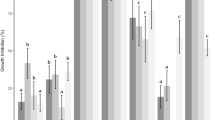Abstract
Essential oils isolated from leaves and seeds of seven umbelliferous plants were tested against the growth ofAspergillus flavus. Those from seeds ofTrachyspermum ammi, Cuminum cyminum, Carum carvi, Daucus carota and from leaves ofAnethum graveolens exhibited antifungal activity against the test fungus. Amongst these, oil from seeds ofTrachyspermum ammi was most toxic. Its minimum inhibitory concentration was 300 ppm, at which it exhibited fungistatic but not phytotoxic properties, when tested at 200, 300 and 400 ppm. The fungitoxic potency ofTrachyspermum seed oil remained unchanged after a long storage period and at high inoculum density of the test fungus. The oil was thermostable and was more efficaceous than the fungicides Agrosan G.N., Benlate, Ceresan, Dithane M-45 and Thiovit commonly used for the control of plant diseases.
Similar content being viewed by others
References
Bajaj BS, Ghosh AK. Antifungal antibiotics in perspective. In: Raychaudhuri SP, Verma A, Bhargava KS, Mehrotra BS eds. Advances in mycology and plant pathology. New Delhi (India): Sagar Printer's, 1975: 297–309.
Beye F. Insecticides from vegetable kingdom. Plant Res Devel 1978; 7: 13–31.
Sbragia RJ. Chemical control of plant diseases an exciting future. Ann Rev Phytopath 1975; 13: 257–67.
Swaminathan MS. Inaugural address. First Botanical Conference of Indian Botanical Society, Meerut, India, 1978: 1–31.
Dixit SN, Srivastava HS, Tripathi RD. Effect of lawsone, a fungitoxic nephthaquinone isolated from leaves ofLawsonia inermis on maize [Abstract]. Ann Meet Indian Soc Pl Physiology 1978: 80.
Dubey NK, Kishore N, Tripathi NN, Tripathi RD, Dixit SN. Fungitoxicity of the essential oil ofCitrus medica against storage fungi: Tests of agrochemical and cultivars. Ann Appl Biol 1982; 100 (Supppl): 58–9.
Fawcetts CH, Spencer DM. Plant chemotherapy with natural products. Ann Rev Phytopath 1970; 8: 403–18.
Langenau IEE. The examination and analysis of essential oils, synthetics and isolates. In: Guenther E, ed. The essential oil. Huntington NY: Krieger Publ, 1948; I: 227–348.
Grover RK, Moore JD. Toximetric studies of fungicides against brown rot organism —Sclerotinia fructicola andS. laxa. Phytopathology 1962; 52: 876–80.
Dikshit A, Singh AK, Tripathi RD, Dixit SN. Fungitoxic and phytotoxic studies of some essential oils. Biol Bull India 1979; 1: 45–51.
Thompson DP. Fungitoxic activity of essential oil components on food storage fungi. Mycologia 1989; 81: 151–3.
Author information
Authors and Affiliations
Rights and permissions
About this article
Cite this article
Dwivedi, S.K., Dubey, N.K. Potential use of the essential oil ofTrachyspermum ammi against seed-borne fungi of Guar (Cyamopsis tetragonoloba L. (Taub.)). Mycopathologia 121, 101–104 (1993). https://doi.org/10.1007/BF01103577
Received:
Accepted:
Issue Date:
DOI: https://doi.org/10.1007/BF01103577




